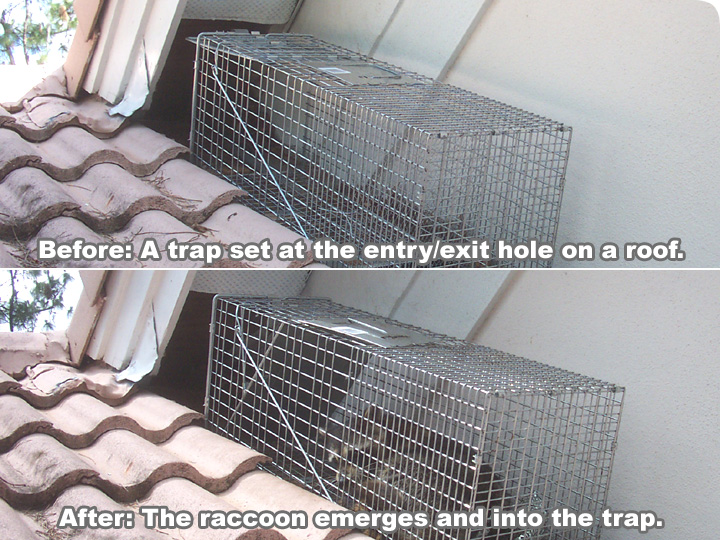
Click the buttons to the left or right for more examples of how the pros set traps in different situations.
In the above photos, this is just a standard roof set by an open dormer eave. Raccoons rip the soffit panels out. In this case, I removed the roof tiles to get a firmer, flatter set on the roof. I didn't seal off the sides, because I didn't know if the animal was inside.
the attic or outside at the time of setting.
If you need professional help, click my Hire A Pro page. I've compiled the USA's best directory of raccoon removal experts.
How to remove raccoons in the attic - Attics, though a necessary part of the home, can sometimes be the bane of homeowners when it comes to nuisance animal control. Raccoons are one of the most common species found in an attic. This animal relies on the ability to climb in order to survive, and you will rarely find a raccoon living in an area where there are no vertical surfaces to escape to. Most raccoons in the attic are females. What this means for you is that there are probably babies raccoons stuffed somewhere inaccessible in the attic. If you’re lucky, and your attic doesn’t have a lot of crazy spaces, you might be able to see the litter as soon as you go into the space. Two things will happen if the mother raccoon is there when you enter: You’ll scare her outside or she’ll remain to defend her young. If the mother flees, you can gather the babies up and use them to lure the adult into a cage trap outside. The mother that chooses to stay needs to be snared with a snare pole and then eased into a kennel for transport. If you manage to catch the adult before you locate the babies, it is very important that you scour your attic looking for the young. Leaving baby raccoons behind to starve to death will not only be cruel, it will result in a terrible odor of decomposition.
Click below photos for more examples of trap sets by professionals:
This is a series of photos of trap sets in the field. These examples are meant to show how professional trap setting looks. The reality is that every case of raccoon trapping is different: number of raccoons, location, type of architecture of the roof or attic they are in, etc. I've done over 1000 raccoon trapping jobs, and every set has been different. There are so many little variables that mean the difference between success and big problems! Trapping is not for amateurs.
If you need professional help, click my Hire A Pro page. I've compiled the USA's best directory of raccoon removal experts.
How to remove raccoons in the attic - Attics, though a necessary part of the home, can sometimes be the bane of homeowners when it comes to nuisance animal control. Raccoons are one of the most common species found in an attic. This animal relies on the ability to climb in order to survive, and you will rarely find a raccoon living in an area where there are no vertical surfaces to escape to. Most raccoons in the attic are females. What this means for you is that there are probably babies raccoons stuffed somewhere inaccessible in the attic. If you’re lucky, and your attic doesn’t have a lot of crazy spaces, you might be able to see the litter as soon as you go into the space. Two things will happen if the mother raccoon is there when you enter: You’ll scare her outside or she’ll remain to defend her young. If the mother flees, you can gather the babies up and use them to lure the adult into a cage trap outside. The mother that chooses to stay needs to be snared with a snare pole and then eased into a kennel for transport. If you manage to catch the adult before you locate the babies, it is very important that you scour your attic looking for the young. Leaving baby raccoons behind to starve to death will not only be cruel, it will result in a terrible odor of decomposition.
Click below photos for more examples of trap sets by professionals:
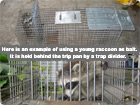 |
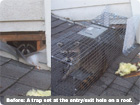 |
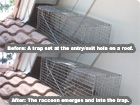 |
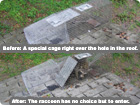 |
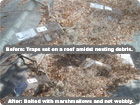 |
This is a series of photos of trap sets in the field. These examples are meant to show how professional trap setting looks. The reality is that every case of raccoon trapping is different: number of raccoons, location, type of architecture of the roof or attic they are in, etc. I've done over 1000 raccoon trapping jobs, and every set has been different. There are so many little variables that mean the difference between success and big problems! Trapping is not for amateurs.

